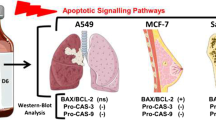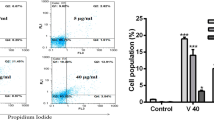Abstract
Many efforts are being made to identify new natural substances for the treatment of cancer. Containing enzymes, non-enzymes, ions, and other organic compounds, scorpion venom is a cytotoxic compound that induces apoptosis and necrosis in mammalian cells, and it could be considered as a potential anticancer agent. In this study, the cytotoxicity effects and the ability of apoptosis induction of Odontobuthus bidentatus scorpion venom on HepG2 cells were investigated. Thereafter, the cells were treated with the scorpion venom. Cell cytotoxicity was evaluated using MTT and neutral red tests. By applying catalase activity assay, determination of accumulated NO in cell culture media and GSH levels in the cells, the changes in the cells redox potential was measured and to determine the apoptosis induction, alkaline comet assay, caspase-3, and cytochrome c release assays were exploited. The expression of bax and bcl-2 genes was evaluated using RT-PCR. Considering MTT and neutral red tests, O. bidentatus scorpion venom depicts cytotoxic effects on HepG2 cells. The venom induces apoptosis by increasing NO levels. The catalase enzyme activity and the GSH level were reduced. Also, the activity of caspase-3 and the release of cytochrome c were increased in venom-treated cells. Expression of bax and bcl-2 genes in the treated cells was significantly increased (P < 0.001). These results suggest that O. bidentatus venom is a suitable source of apoptosis-inducing compounds.









Similar content being viewed by others
References
Abdel-Rahman MA, Omran MAA, Abdel-Nabi IM, Nassier OA, Schemerhorn BJ (2010) Neurotoxic and cytotoxic effects of venom from different populations of the Egyptian Scorpio maurus palmatus. Toxicon 55:298–306
Akef H, Kotb N, Abo-Elmatty D, Salem S (2017) Anti-proliferative effects of Androctonus amoreuxi Scorpion and Cerastes cerastes snake venoms on human prostate cancer cells. J Cancer Prev 22:40
Al-Asmari AK, Islam M, Al-Zahrani AM (2016) In vitro analysis of the anticancer properties of scorpion venom in colorectal and breast cancer cell lines. Oncol Lett 11:1256–1262
Al-Asmari AK, Riyasdeen A, Islam M (2018) Scorpion venom causes upregulation of p53 and downregulation of Bcl-xL and BID protein expression by modulating signaling proteins Erk1/2 and STAT3, and DNA damage in breast and colorectal cancer cell lines. Integr Cancer Ther 17:271–281
Chowell G, Díaz-Dueñas P, Bustos-Saldaña R, Mireles AA, Fet V (2006) Epidemiological and clinical characteristics of scorpionism in Colima, Mexico (2000–2001). Toxicon 47:753–758
Circu ML, Aw TY (2008) Glutathione apoptosis. Free Radic Res 42:689–706
Collins AR (2004) The comet assay for DNA damage and repair. Mol Biotechnol 26:249
Deichman GI (2002) Early phenotypic changes of in vitro transformed cells during in vivo progression: possible role of the host innate immunity. Semin Cancer Biol 4:317–326
Díaz-García A, Ruiz-Fuentes JL, Rodríguez-Sánchez H, Castro JAF (2017) Rhopalurus junceus scorpion venom induces apoptosis in the triple negative human breast cancer cell line MDA-MB-231. J Venom Res 8:9
Ding AH, Nathan CF, Stuehr D (1988) Release of reactive nitrogen intermediates and reactive oxygen intermediates from mouse peritoneal macrophages. Comparison of activating cytokines and evidence for independent production. J Immunol 141:2407–2412
Ding J, Chua P-J, Bay B-H, Gopalakrishnakone P (2014) Scorpion venoms as a potential source of novel cancer therapeutic compounds. Exp Biol Med 239:387–393
Ferlay J, Colombet M, Soerjomataram I, Mathers C, Parkin D, Piñeros M, Zanor A, Bray F (2019) Estimating the global cancer incidence and mortality in 2018: GLOBOCAN sources and methods. Int J Cancer 144(8):1941–1953
Franco R, DeHaven WI, Sifre MI, Bortner CD, Cidlowski JA (2008) Glutathione depletion and disruption of intracellular ionic homeostasis regulate lymphoid cell apoptosis. J Biol Chem 283:36071–36087
Gupta SD et al (2007) Indian black scorpion (Heterometrus bengalensis Koch) venom induced antiproliferative and apoptogenic activity against human leukemic cell lines U937 and K562. Leuk Res 31:817–825
Gwee MC, Nirthanan S, Khoo HE, Gopalakrishnakone P, Kini RM, Cheah LS (2002) Autonomic effects of some scorpion venoms and toxins. Clin Exp Pharmacol P 29:795–801
Jain D, Kumar S (2012) Snake venom: a potent anticancer agent. Asian Pac J Cancer Prev 13:4855–4860
Jiang X, Zheng D, Lin J (2004) Effects of nitric oxide on mitochondrial permeability transition and cytochrome C of human hepatocellular carcinoma cell lines. Zhongguo yi xue ke xue yuan xue bao Acta. Acad Med Sin 26:519–523
Kruger NJ (2009) The Bradford method for protein quantitation. The protein protocols handbook. Springer, New York, pp 17–24
Li X et al (2008) Intrinsic resistance of tumorigenic breast cancer cells to chemotherapy. J Natl Cancer Inst 100:672–679
Lourenco WR, Pezier A (2002) Taxonomic consideration of the genus Odontobuthus Vachon (Scorpiones, Buthidae), with description of a new species. Rev Suisse Zool 109:115–125
Meeran SM, Katiyar SK (2008) Cell cycle control as a basis for cancer chemoprevention through dietary agents. Front Biosci 13:2191
Mosmann T (1983) Rapid colorimetric assay for cellular growth and survival: application to proliferation and cytotoxicity assays. J Immunol Methods 65:55–63
Oltval ZN, Milliman CL, Korsmeyer SJ (1993) Bcl-2 heterodimerizes in vivo with a conserved homolog, Bax, that accelerates programed cell death. Cell 74:609–619
Ortiz E, Gurrola GB, Schwartz EF, Possani LD (2015) Scorpion venom components as potential candidates for drug development. Toxicon 93:125–135
Quintero-Hernández V, Jiménez-Vargas J, Gurrola G, Valdivia H, Possani L (2013) Scorpion venom components that affect ion-channels function. Toxicon 76:328–342
Repetto G, Del Peso A, Zurita JL (2008) Neutral red uptake assay for the estimation of cell viability/cytotoxicity. Nat Protoc 3:1125
Salarian AA, Jalali A, Mirakabadi AZ, Vatanpour H, Shirazi FH (2012) Cytotoxic effects of two Iranian scorpions Odontobuthus doriae and Bothutus saulcyi on five human cultured cell lines and fractions of toxic venom. Iran J Pharm Res 11:357
Sedlak J, Lindsay RH (1968) Estimation of total, protein-bound, and nonprotein sulfhydryl groups in tissue with Ellman's reagent. Anal Biochem 25:192–205
Sifi A, Adi-Bessalem S, Laraba-Djebari F (2017) Role of angiotensin II and angiotensin type-1 receptor in scorpion venom-induced cardiac and aortic tissue inflammation. Exp Mol Pathol 102:32–40
Sinha AK (1972) Colorimetric assay of catalase. Anal Biochem 47:389–394
Zargan J, Sajad M, Umar S, Naime M, Ali S, Khan HA (2011a) Scorpion (Odontobuthus doriae) venom induces apoptosis and inhibits DNA synthesis in human neuroblastoma cells. Mol Cell Biochem 348:173–181
Zargan J, Umar S, Sajad M, Naime M, Ali S, Khan HA (2011b) Scorpion venom (Odontobuthus doriae) induces apoptosis by depolarization of mitochondria and reduces S-phase population in human breast cancer cells (MCF-7). Toxicol In Vitro 25:1748–1756
Zendehdel K (2019) Cancer statistics in IR Iran in 2018. Basic Clin Cancer Res 11:1–4
Zhang YY, Wu LC, Wang ZP, Wang ZX, Jia Q, Jiang GS, Zhang WD (2009) Anti-proliferation effect of polypeptide extracted from scorpion venom on human prostate cancer cells in vitro. J Clin Med Res 1:24
Acknowledgements
The authors thank the Biology department of Imam Hossein University for supporting this article.
Funding
The manuscript is part of a Ph.D thesis done by Hani Keshavarz Alikhani in the Imam Hossein University, Tehran, Iran. Funding was provided by Razi University.
Author information
Authors and Affiliations
Corresponding author
Ethics declarations
Conflict of interest
The authors declare that there are no conflicts of interest.
Ethical Approval
Scorpions (Odontobuthus bidentatus) were collected under permission from the Ministry of Health, Govt. of Iran.
Additional information
Publisher's Note
Springer Nature remains neutral with regard to jurisdictional claims in published maps and institutional affiliations.
Rights and permissions
About this article
Cite this article
Keshavarz Alikhani, H., Bidmeshkipour, A. & Zargan, J. Cytotoxic and Apoptotic Induction Effects of the Venom of Iranian Scorpion (Odontobuthus bidentatus) in the Hepatocellular Carcinoma Cell Line (HepG2). Int J Pept Res Ther 26, 2475–2484 (2020). https://doi.org/10.1007/s10989-020-10029-3
Received:
Revised:
Accepted:
Published:
Issue Date:
DOI: https://doi.org/10.1007/s10989-020-10029-3




